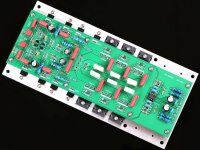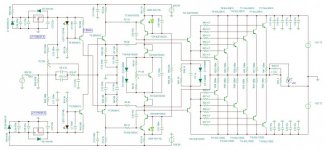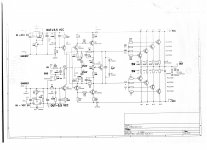That's OK. I had to mount output stage of Krell KSA-50 on a large aluminium L profile because TO.3 devices can not be mounted directly on a flat back heat sink.I was thinking of using 8 or 10mm thick aluminium bars, approx. 150 by 80 mm to do the 3 mm threads and then attach the amplifier/power transistors to the aluminium bar using the 3 mm screws and then attach the whole aluminum bars/amplifier subassembly with screws/nuts going through the large heatsinks of the chassis, using heatsink paste . That way I will not risk "ruining" the large heatsink and I can reuse the heatsinks/case should I not like this particular amp.
Use a large aluminium bar in a fashion similar to the one this card is attached to:
Just use M5 screws for fixing the subassembly since they are mechanically sturdier than M3. Aluminium threads scrape off so easily.
Heatsink/chassis cost
Expensive cheese 🙂
Heatsinks/cases seem to cost more than most amplifier assembled cards!
I wish there was a standard for hole patterns for aluminium subbars in amplifier heatsinks..
An excellent idea. Being lazy i ended up having lots of heatsinks that look like swiss cheese 😀
Expensive cheese 🙂
Heatsinks/cases seem to cost more than most amplifier assembled cards!
I wish there was a standard for hole patterns for aluminium subbars in amplifier heatsinks..
Sorry, I took that dimension from the recipe for Swiss cheze!😉If you need to tap for 3mm you should drill with 2.5mm.
Metric threads geometry is such that the tap drill formula is nominal screw diameter less the pitch spacing for any metric tap drill. Make sure the tap drill actually is not oversized (cheap drill sets are not very accurate!). Many charts have errors so do the calculation to check! In soft materials slightly undersized holes can be tapped, in steel you'll probably break your tap if you try this.If you need to tap for 3mm you should drill with 2.5mm.
Cheap tap sets are usually poor tolerance, which is bearable for large sizes, but for M2.5 / M3 you really need a quality tap that's the right size, or you'll have useless or stripped threads.
Standard metric hardware is "coarse thread", sizes and pitches are M2.5/0.45, M3/0.5, M4/0.7, M5/0.8, M6/1.0, M8/1.25.
M2.5 and M3 are the commonest sizes for semiconductor mounting, for instance a metal-tab TO220 hole is 3.5mm, and the insulating bushing for same is ~2.9mm ID to fit an M3 bolt (nominal diameter for metric is not the actual bolt diameter). Insulating bushings may be thicker than the tab, in which case you either need to sand them down, add a spacer with 3.5mm hole, or use a 3.5mm hole in the heatsink and a nut the other side.
Someone here asked if it is possible to purchase a board with 3 output pairs. Here it is, with additional feature: a circuit for midpoint automatic adjustment is added too. A single channel bare board costs about €15.
Dartzeel board at China Voice Store
Dartzeel board at China Voice Store
Attachments
that servo circuit for controlling the offset is a real hit.
I having greatly modified the original scheme bringing the final power section from 1 to 4 pairs, now, I think that the least worst of that scheme, except distorting it, is to go back to one pair, work on the input cap, on the supercap and on the power supplies
if you really want that pattern
otherwise we work much better with the diagram of the 458 with which they eliminated some problems of the electrical diagram 108
I having greatly modified the original scheme bringing the final power section from 1 to 4 pairs, now, I think that the least worst of that scheme, except distorting it, is to go back to one pair, work on the input cap, on the supercap and on the power supplies
if you really want that pattern
otherwise we work much better with the diagram of the 458 with which they eliminated some problems of the electrical diagram 108
Last edited:
Thanks Domenico for this info. 🙂that servo circuit for controlling the offset is a real hit.
I having greatly modified the original scheme bringing the final power section from 1 to 4 pairs, now, I think that the least worst of that scheme, except distorting it, is to go back to one pair, work on the input cap, on the supercap and on the power supplies
if you really want that pattern
otherwise we work much better with the diagram of the 458 with which they eliminated some problems of the electrical diagram 108
Perhaps the most important piece of information is lost in Italian-to-English translation.
Therefore, direct questions:
1) can you recommend this board?
2) currently, which is the best commercially available version?
Perhaps a top-list.
It is so good to have experts here.
Thanks again
Perhaps the most important piece of information is lost in Italian-to-English translation.
I can offer a slightly prejudiced interpretation 🙂
1. Multiple pairs in this circuit sound like crap
2. Servo sounds like crap
3. Use better parts than the tight fisted Swiss.
Thanks Domenico for this info. 🙂
Perhaps the most important piece of information is lost in Italian-to-English translation.
Therefore, direct questions:
1) can you recommend this board?
2) currently, which is the best commercially available version?
Perhaps a top-list.
It is so good to have experts here.
Thanks again
I think the 108 is a scheme with some technical problems, input cap, adjustment, super cap that was added later and with a little bit of pressure. I do not understand all that power and those super transformers if it does not go down and if even with 2 caps per dog instead of 6 changes nothing.
It has some good prerogatives, good sound of high, medium high and medium, poor on low and medium low and dynamic in general: but it is clear, even without listening to it, it is an open ring
If you want to work with the scheme 108 I think it is better to buy the Chinese card with a single pair, better disassembled and carefully select the input transistors and put them in close contact, which Chinese cards do not do.
I think the two 3.3 micro input caps are bad.
I think the super cap should be bypassed.
All those filter caps are not needed, they only serve to try to justify the crazy price of 108.
We have done this or these interventions.
I do not recommend the 4 couples due to careful selection of the finals.
I recommend a completely stabilized power supply, it costs less than the filter caps and works much better.
If you want, I can give you a schematic and gerber of the printout
Domenico, have you already built something along the 458 supposed circuit?
I finished the drawings of the printout.
One printed with the stabilizer also of the power amplifiers and input stabilizer.
If anyone is curious to see them place them
I can offer a slightly prejudiced interpretation 🙂
1. Multiple pairs in this circuit sound like crap
2. Servo sounds like crap
3. Use better parts than the tight fisted Swiss.
😀
I finished the drawings of the printout.
One printed with the stabilizer also of the power amplifiers and input stabilizer.
If anyone is curious to see them place them
[I finished the drawings of PCB, not printout
You mean this oneDomenico, have you already built something along the 458 supposed circuit?
 😎 Made in Hungary!😱
😎 Made in Hungary!😱
Attachments
You mean this one😎 Made in Hungary!😱

MY VERY MODEST OPINION:
little sense seems a patched and bad 108
this is okay
Attachments
Last edited:
@Domenico
Thanks a lot for all your advice.
I already had some "gut feeling" that there is lots of spin about Dartzeel and that many "whistles and bells" where added to attract certain type of customers. I think Swiss company is "biasing" price more than their devices.
I have two pairs of bare original boards and I intend to buy one pair more.
I am just a newbie in electronics but I think NHB-108 is the right thing to start learning.
My new project will involve yours suggestions, "Ultima Legione" ideas and ideas presented almost forgotten Danny, who had also presented some smart advice.
I know, there will be lots of soldering and-de-soldering but a great deal of fun too.
Regarding the character of NHB-108 it seems it is the best candidate for bi-amping, taking the role of feeding mid and tweeter and other amplifier for woofer. Just my 2 cents.
Grazie mille!🙂
EDIT: In fact, Dartzeel is just fine for my taste for music which doesn't require really pronounced bass. Except for some organo works, classical music doesn't require bass that much, but needs and requires more detail.
Thanks a lot for all your advice.
I already had some "gut feeling" that there is lots of spin about Dartzeel and that many "whistles and bells" where added to attract certain type of customers. I think Swiss company is "biasing" price more than their devices.
I have two pairs of bare original boards and I intend to buy one pair more.
I am just a newbie in electronics but I think NHB-108 is the right thing to start learning.
My new project will involve yours suggestions, "Ultima Legione" ideas and ideas presented almost forgotten Danny, who had also presented some smart advice.
I know, there will be lots of soldering and-de-soldering but a great deal of fun too.
Regarding the character of NHB-108 it seems it is the best candidate for bi-amping, taking the role of feeding mid and tweeter and other amplifier for woofer. Just my 2 cents.
Grazie mille!🙂
EDIT: In fact, Dartzeel is just fine for my taste for music which doesn't require really pronounced bass. Except for some organo works, classical music doesn't require bass that much, but needs and requires more detail.
Last edited:
it seems it is the best candidate for bi-amping,
Тhis is how i am using it at present. The weakest features: bass and dynamics, are much better this way.
- Home
- Amplifiers
- Solid State
- Dartzeel amp schematic - build this?


